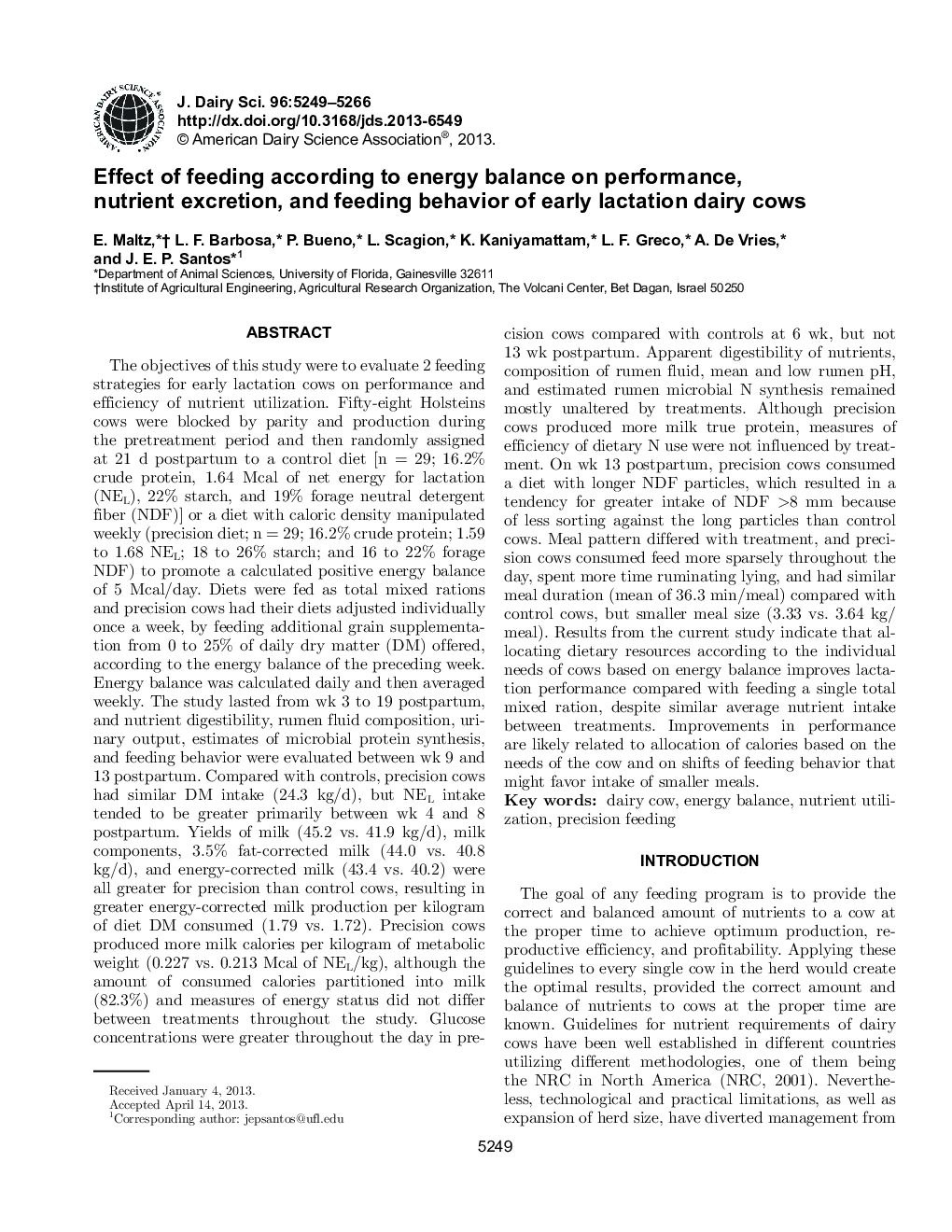| کد مقاله | کد نشریه | سال انتشار | مقاله انگلیسی | نسخه تمام متن |
|---|---|---|---|---|
| 2438904 | 1108051 | 2013 | 18 صفحه PDF | دانلود رایگان |
عنوان انگلیسی مقاله ISI
Effect of feeding according to energy balance on performance, nutrient excretion, and feeding behavior of early lactation dairy cows
دانلود مقاله + سفارش ترجمه
دانلود مقاله ISI انگلیسی
رایگان برای ایرانیان
کلمات کلیدی
موضوعات مرتبط
علوم زیستی و بیوفناوری
علوم کشاورزی و بیولوژیک
علوم دامی و جانورشناسی
پیش نمایش صفحه اول مقاله

چکیده انگلیسی
The objectives of this study were to evaluate 2 feeding strategies for early lactation cows on performance and efficiency of nutrient utilization. Fifty-eight Holsteins cows were blocked by parity and production during the pretreatment period and then randomly assigned at 21 d postpartum to a control diet [n = 29; 16.2% crude protein, 1.64 Mcal of net energy for lactation (NEL), 22% starch, and 19% forage neutral detergent fiber (NDF)] or a diet with caloric density manipulated weekly (precision diet; n = 29; 16.2% crude protein; 1.59 to 1.68 NEL; 18 to 26% starch; and 16 to 22% forage NDF) to promote a calculated positive energy balance of 5 Mcal/day. Diets were fed as total mixed rations and precision cows had their diets adjusted individually once a week, by feeding additional grain supplementation from 0 to 25% of daily dry matter (DM) offered, according to the energy balance of the preceding week. Energy balance was calculated daily and then averaged weekly. The study lasted from wk 3 to 19 postpartum, and nutrient digestibility, rumen fluid composition, urinary output, estimates of microbial protein synthesis, and feeding behavior were evaluated between wk 9 and 13 postpartum. Compared with controls, precision cows had similar DM intake (24.3 kg/d), but NEL intake tended to be greater primarily between wk 4 and 8 postpartum. Yields of milk (45.2 vs. 41.9 kg/d), milk components, 3.5% fat-corrected milk (44.0 vs. 40.8 kg/d), and energy-corrected milk (43.4 vs. 40.2) were all greater for precision than control cows, resulting in greater energy-corrected milk production per kilogram of diet DM consumed (1.79 vs. 1.72). Precision cows produced more milk calories per kilogram of metabolic weight (0.227 vs. 0.213 Mcal of NEL/kg), although the amount of consumed calories partitioned into milk (82.3%) and measures of energy status did not differ between treatments throughout the study. Glucose concentrations were greater throughout the day in precision cows compared with controls at 6 wk, but not 13 wk postpartum. Apparent digestibility of nutrients, composition of rumen fluid, mean and low rumen pH, and estimated rumen microbial N synthesis remained mostly unaltered by treatments. Although precision cows produced more milk true protein, measures of efficiency of dietary N use were not influenced by treatment. On wk 13 postpartum, precision cows consumed a diet with longer NDF particles, which resulted in a tendency for greater intake of NDF >8 mm because of less sorting against the long particles than control cows. Meal pattern differed with treatment, and precision cows consumed feed more sparsely throughout the day, spent more time ruminating lying, and had similar meal duration (mean of 36.3 min/meal) compared with control cows, but smaller meal size (3.33 vs. 3.64 kg/meal). Results from the current study indicate that allocating dietary resources according to the individual needs of cows based on energy balance improves lactation performance compared with feeding a single total mixed ration, despite similar average nutrient intake between treatments. Improvements in performance are likely related to allocation of calories based on the needs of the cow and on shifts of feeding behavior that might favor intake of smaller meals.
ناشر
Database: Elsevier - ScienceDirect (ساینس دایرکت)
Journal: Journal of Dairy Science - Volume 96, Issue 8, August 2013, Pages 5249-5266
Journal: Journal of Dairy Science - Volume 96, Issue 8, August 2013, Pages 5249-5266
نویسندگان
E. Maltz, L.F. Barbosa, P. Bueno, L. Scagion, K. Kaniyamattam, L.F. Greco, A. De Vries, J.E.P. Santos,